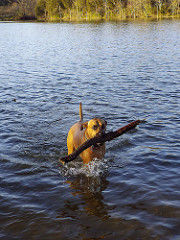
Lately I’ve noticed a big difference between all the animals in my household in the amount of water they drink. One of my cats daintily sips her water, playing with it more than anything else. Another will practically dunk his head into the fountain and gulp while the third is so rarely seen drinking from his bowl you’d think he never touched the stuff. In fact the only way I know he does drink is from catching him in the bathroom sink and tub helping himself to some fresh droplets. The two dogs are also quite different. Where our little one drinks constantly, my Mowgli hardly ever visits the water dish.
Blood work has been done on everyone and none of them came back dehydrated, and all were healthy (excessive drinking can be signs of diabetes and/or kidney disease, among many others). Now if you are like me and would like to be able to monitor your animals health without having to do blood work all the time, there are some things you can look for at home regarding possible dehydration.
First off, realize that just like humans, our animals hydrate through both food and drink. If you have an animal that hardly drinks at all yet remains perfectly hydrated, he or she is probably getting enough H2O from all the materials he or she ingests. I’ve found that my animals on raw diets end up drinking very little of their daily water and instead take it in through their food. Secondly, just because your animal is drinking copious amounts of water does not mean that he or she is retaining it. If there is an underlying disease process occurring all that water may be for naught. When this is a concern, it is always a good idea to visit the doctor and have things checked. 
Now that we’ve cleared all that up, let’s discuss some ways you might be able to detect if one of your pets is dehydrated right at home. One of the simplest tests one can do is to pull up the scruff in between the shoulders and see how quickly it returns to it’s normal positioning. Much like the test with humans, raising the skin and pinching it is a great way to check hydration levels. Skin that takes longer than a few moments to return to normal is in danger of being dehydrated. The more time it takes, the greater the level of dehydration. Why does this happen? When the body is hydrated, there is a greater amount of elasticity within the skin. Decreased water levels mean decreased elasticity, disallowing the skin to return as quickly as it should.
Another common symptom is dryness in the gums. The gums should be moist and the saliva should not be thick. In a dehydrated animal the gums will become dry and the saliva more viscous. While looking at the face, check your animal’s eyes. Do they look sunken? This is another symptom often associated with dehydration. When an animal is dehydrated they may exhibit signs of exhaustion or lethargy. If there’s not enough fluid circulating in the body, nutrients imperative to the well being of our pets will often be decreased or delayed in being delivered to their final destinations. If your pet is on supplementation or medication, these too can become ineffective while dehydrated because they are dependent on a well-hydrated system to help with circulation.
Needless to say water is important, and sometimes we forget how important. Personally I find that carrying a water bottle and eating water rich foods is the only way I stay hydrated. When your animal runs in from outside and takes a dive head first into the water dish, realize that the body can only handle a certain amount at one time. Anything above and beyond that will be wasted. A healthy diet and having water readily available to them all day is imperative to optimum function. Keep your fur baby and you hydrated this summer!
Photo Credits:
Stay Hydrated via photopin (license)
Thirst via photopin (license)
214/365 via photopin (license)
Walk Softly But Carry a Big Stick via photopin (license)
Sweet dog via photopin (license)
This lady loves the sunshine via photopin (license)
playing via photopin (license)

